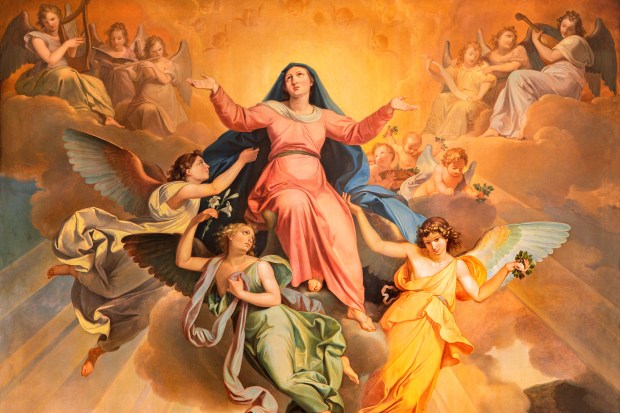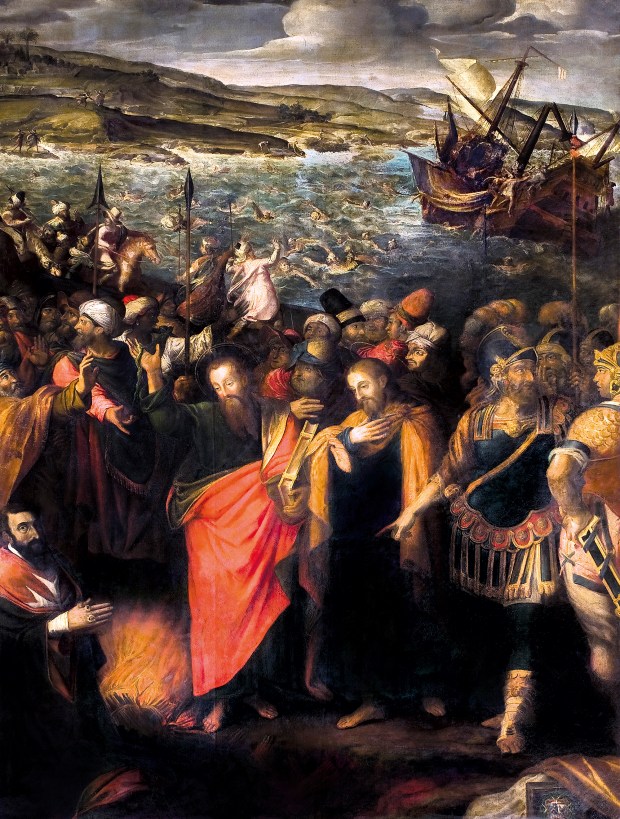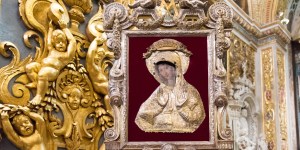In the first year of his pontificate, Pope John Paul II wrote his encyclical Redemptor Hominis – Redeemer of Man. It was a continuation of sorts of the teachings found in the Second Vatican Council’s Gaudium et Spes (Joy and Hope). The Pope’s text can be read as a thoughtful meditation on a powerful statement found in Gaudium et Spes: “Christ, the new Adam, fully reveals man to man himself.” This statement highlights a fundamental aspect of Christian theology and anthropology: truly grasping what it means to be human means meditating on Christ’s own humanity.
This reflection is particularly relevant as we contemplate the Feast of the Assumption, celebrated on August 15 – a feast deeply intertwined with the revelation of what it means to be human. Back in 2018, Pope Francis invited the faithful to contemplate the mystery of the Assumption, explaining that this Marian feast shows us God’s intention to save the whole human person – soul and body.
Understanding our humanity through Christ
The reflections of Pope John Paul II, as well as the teachings of Pope Francis, anchor the idea that Christ is the lens through which we can truly understand our humanity. As the new Adam, Christ reveals the fullness of what it means to be human. His life, death, and resurrection provide a roadmap for us to follow – a blueprint for living a life of meaning, virtue, and ultimate fulfillment.
Mariology teaches us that as Christ is the new Adam, Mary is the New Eve. The feast of the Assumption is not only about honoring the Blessed Virgin Mary, but also about recognizing the profound truth of our own destiny. Pope Francis has explained that humanity is a unity of body and soul, so intricately linked that neither can be fully understood without the other. This understanding is reflected in the Creed, recited by Catholics every Sunday, which affirms belief in the resurrection of the dead.

As the resurrection of Jesus with his glorified body points to our own future resurrection, the Assumption of Mary confirms our glorious destiny. Pope Francis noted that while ancient Greek philosophers recognized the immortality of the soul, they often dismissed the body as a mere temporary vessel or even a prison. In contrast, Christian revelation holds that the body, too, is destined for eternal glory. This belief is central to our faith and is vividly illustrated in the Assumption of Mary.
The Assumption in tradition and scripture
The Assumption of Mary into heaven, body and soul, was declared a dogma of the Catholic faith by Pope Pius XII on November 1, 1950. However, the tradition of honoring this event goes back much further, as the feast has been celebrated on August 15 since ancient times in both Eastern and Western Christianity.
While some interpret passages from the New Testament (Revelation 12) as allusions to the Assumption, Scripture does not explicitly describes the end of Mary’s earthly life. The passage speaks of a woman pursued by a dragon who is given wings to escape into the desert, a vision that many associate with Mary’s Assumption. Early apocryphal texts, such as the Transitus Mariae (the “Passing of Mary”) provide some of the earliest accounts of Mary’s death and assumption. While not part of the canonical scriptures, these writings offer an exceptional window into the early Christian belief and tradition surrounding this event.

The oldest of these texts, thought to have been written in the 2nd century, possibly by a disciple of John the Evangelist, suggests that the tradition of Mary’s Assumption was well established in the early Church. Archaeological evidence and linguistic analysis of these texts further support their early origin and indicate a deep and ancient reverence for this event among the early Christians.
Theological insights and early Christian faith
St. Epiphanius of Salamis, writing in the late 4th century, reverently pondered on the mystery of the end of Mary’s life. Whereas he speculates on various possibilities (whether she died or was taken alive to heaven), he ultimately concludes that the details of her departure remain somewhat unknown, emphasizing that God’s power is beyond human understanding. Epiphanius’ writings also suggest that the traditions of Mary’s Dormition and Assumption were already circulating in the early Church.
But by the 6th century, the feast of the Assumption was firmly established in the Christian liturgical calendar, celebrated throughout the Eastern Roman Empire by order of Emperor Maurice. In the West, the earliest traces of the feast appear in the late 5th century, and it was soon adopted as one of the most important feasts of the Church, as evidenced by the actions of Pope Sergius I in the 7th century.
John Damascene, the prominent 8th-century theologian, elaborated on the meaning of the Assumption in his sermons. He teaches that while Mary’s soul and body were separated at death, her body did not decay but was preserved and glorified in heaven. This teaching reinforces the belief in the resurrection of the body, and the unity of the human person in life and death.
The Assumption and its special place in Maltese devotion
The Assumption of the Blessed Virgin Mary holds a special place in the hearts of the Maltese people, where Mary is known as Santa Marija Assunta. This feast has been deeply rooted in Maltese religious tradition for centuries, and churches and chapels dedicated to the Assumption can be found throughout the islands.
Devotion to the Assumption in Malta can be traced back to the early Christian era. The Assumption is the title by which the Blessed Virgin Mary is the Patroness of the Maltese Islands. Indeed, the Maltese are well known for their deep Catholic faith and their centuries-old devotion to the Blessed Virgin Mary. The Maltese Christian community is as old as those of Ephesus, Jerusalem, Corinth and Rome, thanks to the Apostle Paul – which explains its 2,000 years of Christian history. The Blessed Virgin has always had an important place in the Maltese Christian tradition. When the Apostle was shipwrecked on the archipelago’s shores, he was accompanied by Luke – the most Marian of all Evangelists. Luke is also the author of the Acts of the Apostles, and the fact that he uses the first person plural “we” when recounting the shipwreck in Acts 28 further proves that the first Mariologist was with Paul (“When we were safely ashore,” Luke writes, “we found that the island was called Malta.”) Therefore, it is likely that Luke spoke to the Maltese about the Mother of the Savior – and that they warmly received his words.

Some of the still-standing oldest parishes dedicated to the Assumption in Malta date back to the 15th century. But by the 1800s, Malta boasted 92 churches and 22 altars dedicated to the Assumption – many of which had already existed for centuries. Although many of these ancient chapels have since been lost or repurposed, the deep reverence for the Assumption remains a cornerstone of Maltese Catholic identity.
Today, nine parishes in Malta still celebrate the Assumption as their main feast day. The event is marked by popular processions, Masses, and community celebrations. The feast is considered among the most important ones in the Maltese liturgical calendar, showing the enduring devotion of the Maltese people to the Blessed Virgin Mary.
The Assumption in Gozo: A national shrine and its historic tradition
Gozo, Malta’s sister island, celebrates the Assumption of the Blessed Virgin Mary with equal fervor. The national Marian shrine of Gozo, the famed Sanctuary of the Madonna Ta’ Pinu, is dedicated to the Assumption. It is thus a focal point of Marian devotion –not only in the Maltese archipelago, but in the Mediterranean.
The Marian Shrine of Ta’ Pinu in Malta is an exceptional site, not only because of its calm, majestic architecture, but mainly because of the miraculous events associated with it. Originally a small chapel dedicated to the Assumption, it was later named Ta’ Pinu after Pinu Gauci, the procurator of the Church in 1598. The chapel became famous in 1883, when Karmni Grima, a pious woman from Għarb, heard a mysterious voice calling her three times. She was led to the chapel, where the voice instructed to recite three Hail Marys. She kept this secret for two years until she shared it with Franġisk Portelli, who had a similar divine encounter. His mother’s miraculous healing further solidified the chapel’s reputation for divine intervention.

The image of Our Lady of Ta’ Pinu, central to these events, depicts the Blessed Virgin Mary being crowned as Queen of Heaven – an event traditionally related to her Assumption. One can see the apostles standing around an open tomb. This is a classic iconographic detail in ancient Byzantine icons of Mary’s Dormition that still survive in later Maltese iconography. Indeed, Byzantine traditions describe how the apostles, scattered throughout the world, were miraculously brought to her side at the time of her transit.
Ta’ Pinu’s image is naturally revered for its association with the miraculous experiences of Karmni and Franġisk. Pilgrims flock to the shrine, as is evidenced by the numerous ex-votos that adorn its walls testifying to miracles of all sorts.
Interestingly, the Cathedral in Gozo’s capital, Victoria, is also dedicated to the Assumption, continuing a tradition that dates back to ancient times. This is the highest ranking church (and possibly the oldest) in the Archipelago dedicated to the Assumption of Mary. Indeed, the historical roots of Marian devotion in Gozo are intertwined with the early Christian history of the island. According to tradition, soon after converting to Christianity following the shipwreck of St. Paul in the year 60, the Gozitans dedicated their main pagan temple to the Mater Dei, the Mother of God. Archaeological evidence supports the existence of a temple dedicated to Juno on the site of the current cathedral – indicating a long tradition of worship at this sacred site.
A celebration of our glorious destiny
The Maltese regard the Feast of the Assumption as a profound celebration of faith, hope and human destiny. Their devotion reminds us that, like Mary, we are called to a glorious future – a future that embraces our whole being: the Assumption affirms the unity of the human person, and the Christian hope in the resurrection of the body.
Through the Assumption, we are invited to see in Mary’s glorification the fulfillment of God’s promise to all humanity. As we honor the Blessed Virgin Mary, we also renew our hope in the resurrection and eternal life that awaits us. The Assumption is not only a celebration of Mary’s unique privilege, but also a foreshadowing of the destiny that God has prepared for each of us – a destiny that, in the words of St. Irenaeus, reveals the glory of God in a fully living human being, and that Maltese Marian devotion has as its horizon.



